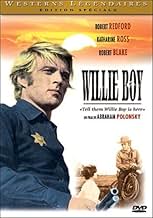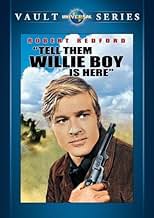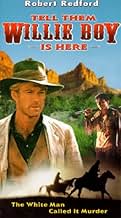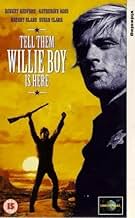Als der junge Paiute-Indianer Willie Boy in sein kalifornisches Reservat zurückkehrt, um mit Lola zusammen zu sein, deren Vater ihn missbilligt, kommt es zu einem Mord in Notwehr, der eine g... Alles lesenAls der junge Paiute-Indianer Willie Boy in sein kalifornisches Reservat zurückkehrt, um mit Lola zusammen zu sein, deren Vater ihn missbilligt, kommt es zu einem Mord in Notwehr, der eine große Menschenjagd nach Willie auslöst.Als der junge Paiute-Indianer Willie Boy in sein kalifornisches Reservat zurückkehrt, um mit Lola zusammen zu sein, deren Vater ihn missbilligt, kommt es zu einem Mord in Notwehr, der eine große Menschenjagd nach Willie auslöst.
- Regie
- Drehbuch
- Hauptbesetzung
- 2 BAFTA Awards gewonnen
- 3 Gewinne & 1 Nominierung insgesamt
- Digger
- (as Eric Holland)
- Meathead
- (as Lee De Broux)
Empfohlene Bewertungen
The film covers several genres & comments upon them in interesting ways: it is a Western w. conventional themes (turned upside down & inside out) of Indian savages vs. white civilizers; it is a historical drama that chronicles the rise to power of the industry elites in late 19th century CA. (illustrated in the subplot of Pres. Taft's visit to the Riverside Inn). While this is a Western, it might be better termed an anti Western. Every character (including Blake's Indian) is weak, vacillating & morally changeable, which makes for a wonderfully complex tale.
Blakes dialogue gives us the film's title: "Well, at least they'll know that Willie Boy was here." He says this in responding to Katherine Ross' comment asking why he is willing to keep running, even though the whites will eventually trap & kill him. This scene conveys the film's elegaic tone about the death of the "romantic" West & the rise of the homogenized, white, industrial CA. that would arise in the 20th century. Willie is compelled to stand up for his own individuality even though in actuality few will mourn his passing & even fewer remember that "he was here." But Polonsky, the filmmaker, tells us that someone will indeed remember Willie beyond those tracking him down & exterminating him: Polonsky himself & the viewers of the film. Really cool stuff!
Another powerful layer of history is Abraham Polonsky's involvement. As a Hollywood 10 member, the script seems to comment indirectly on the Hollywood Blacklist era. Blake the hounded Indian is much like the renegades of the Hollywood 10. Willie Boy tries to stand up for the principle of honor & freedom in the face of insurmountable social odds. Yet, he is never seen as a romanticized or one sided character. Even Willie Boy is pig headed, monomaniacal and self-destructive.
I think Blake does a great job in this role. It makes you remember how good he could be in film roles (remember "In Cold Blood?") before "Baretta" came along. And it makes you weep for his recent descent into hell & wonder at what might have been if his life & career had taken diff. turns.
I didn't mind Katherine Ross as much as some viewers. She was much less bothersome & stereotypical than in some of her other roles ("The Graduate" & "Butch Cassidy"). During the film I was actually realizing how much I liked her in her role which surprised me.
I highly recommend this film.
The title role of Tell Them Willie Boy Is Here is played by Robert Blake who is a Paiute Indian kid who by their tradition kidnaps the women of his intentions Katherine Ross to make her his bride. It's their way of courtship, but when Ross's dad objects he's accidentally shot and killed by Blake.
Ironically with a good lawyer Blake might have gotten off. But Paiute Indians usually don't get good lawyers and they don't take to confinement. Still this incident might have gone unnoticed but for the fact that the sitting president of the USA in 1909 one William Howard Taft was visiting the area. That brings in the national media and blows up the story.
Robert Redford plays the sheriff charged with bringing in Blake dead or alive. He never played quite the roughneck character he does in this film than in any other work I can recall. Susan Clark plays the doctor on the Paiute reservation who has her views routinely ignored as she's mansplained on a regular basis. She also has her needs fulfilled by Redford as both are the best of what's out there in their corner of the world.
It's Blake and Ross who really capture your attention. I'm sure that William Shakespeare would have seen so readily the parallels between his timeless classic and what Blake and Ross are all about.
Well paced film with bitter irony and stunningly directed by Abraham Polonsky , this was once-blacklisted Polonsky's first movie in 31 years . A thought-provoking and powerful picture , even though the screenplay carries its liberal conscience on its sleeve . Main cast is very good . Robert Blake is awesome as an obstinate Indian presumed guilty of a crime defined by circumstance rather than by fact, he gradually reverts to being an Indian in the archetypally savage sense . A sober Robert Redford gives fine acting , he plays as a reluctant as well as stubborn sheriff who pursues mercilessly Willie . And Katharine Ross is very attractive as the bride who follows to Boy . Support cast is frankly nice such as Susan Clark , Barry Sullivan , John Vernon , Charles McGraw, Robert Lipton and Ned Romero .
Colorful and evocative cinematography by maestro cameraman Conrad L. Hall including wonderful desert outdoors and masterfully photographed . Special mention for the thrilling and suspenseful musical score with atmospheric and strange sounds by Dave Grusin , in Jerry Goldsmith style . Enjoyable production design with marvelous landscapes by two veteran designers : Alexander Golitzen and Henry Burnstead, Hitchcock's ordinary. The motion picture was compellingly directed by Abraham Polonsky, it was made with austere authority , adding a strong allegory about witch-hunting . This was Polonsky's retun to filmmaking after 21 blacklist years since Force of Evil with this excellent contemporary western . The best and most successful movie he directed was the classic film noir "Force of evil" and also wrote the prestigious Body and Soul . Subsequently , he was chased as a member of the communist party . After defying the comittee by refusing to name names , 8Polonsky was pursued , juzged and condemned by the HUAC , once blacklisted he only wrote and directed a few films as Romance of a horsethief and this Tell them willie Boy is here. And wrote some scripts such as I can get it for you wholesale , Madigan , Monsignor, Avalanche express Rating : 7/10. Better than average , well worth watching
Director Abraham Polonsky was making his comeback to mainstream cinema with this film, eighteen years after being blacklisted by the UnAmerican Activities Committee. He also wrote this screenplay, which strikes a defiant note in favour of the lone hero against the forces of intolerance and repression. It is not too fanciful to see the indians, with their alternative sensibility and distinct code of values, as a metaphor for artists and free thinkers. Minorities are always in danger, suggests the film, from the urge to hound and victimise manifested by some elements in society.
Polonsky skilfully uses the camera to tell his story. We follow the complex movements of the various characters around the fiesta fairground without the need for spoken dialogue. The silent meeting of Coop and Willie tells us everything about these two men, and their mutual rivalry and respect.
The wonderful topography of the Mojave Desert is superbly captured in Panavision. In particular, the showdown on Ruby Mountain offers some gorgeous images. The film's four leads are excellent: Robert Redford is a wise and humane Coop, the sherriff obliged to lead the inappropriate manhunt: Robert Blake is perfect as the nihilistic, elemental Willie: Doctor Elizabeth Arnold is played by Susan Clark, developing nicely the ambivolence of a woman who needs Coop sexually but despises herself for it: Katharine Ross is the spry, athletic Lola, the young indian girl who becomes Willie's 'wife by capture'.
Wusstest du schon
- WissenswertesAbraham Polonsky said to a USC film class at the time that he purposely shot and edited the manhunt sequences with characters moving in all directions across the screen, rather than in the usual way wherein both runners and pursuers would move in the same direction across the shots (i.e., left to right) to enhance the impression of urgent suspense in a chase. Instead, Polonsky was looking for a different feel for the audience, of the characters wandering, feeling their way through the landscape. He implied he was willing to sacrifice some suspense to externalize the characters' confusion. He also said that for Katharine Ross' brief, artfully lit nude shot, he exposed the film correctly but then produced a high-contrast copy of the same film frames with deep blacks and transparent lights, then bi-packed both pieces of films together to rephotograph. The high-contrast overlay ensured that the shadows on Ross' body were black--so that the image could not reveal more in the shadows than it was supposed to.
- PatzerMany of the hats worn in the film are not the style worn during the early part of the 20th century. Some in fact, could only have been sewn using machines created in the 1950s, nearly half a century after the film's setting.
- Zitate
Dr. Elizabeth Arnold: Willie killed Mike and took Lola. They call it marriage by capture. The mother knew that and told her to go.
- VerbindungenFeatured in Red Hollywood (1996)
Top-Auswahl
- How long is Tell Them Willie Boy Is Here?Powered by Alexa
Details
- Erscheinungsdatum
- Herkunftsland
- Sprache
- Auch bekannt als
- Willie Boy
- Drehorte
- Pioneertown, Kalifornien, USA(shoot out near end, Pipes Canyon)
- Produktionsfirma
- Weitere beteiligte Unternehmen bei IMDbPro anzeigen
Box Office
- Weltweiter Bruttoertrag
- 5.949 $
- Laufzeit1 Stunde 38 Minuten
- Farbe
- Seitenverhältnis
- 2.39 : 1
Zu dieser Seite beitragen







































